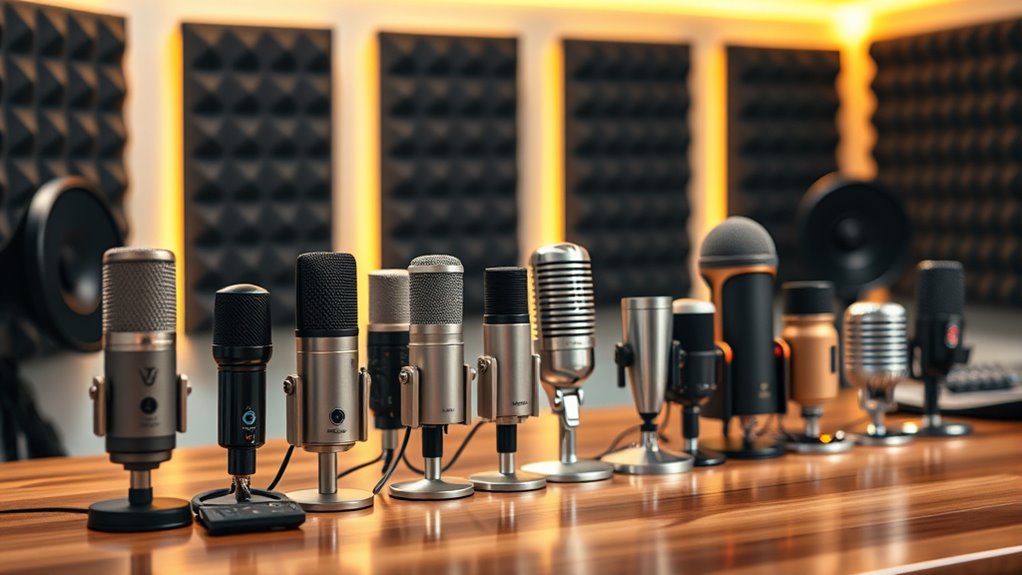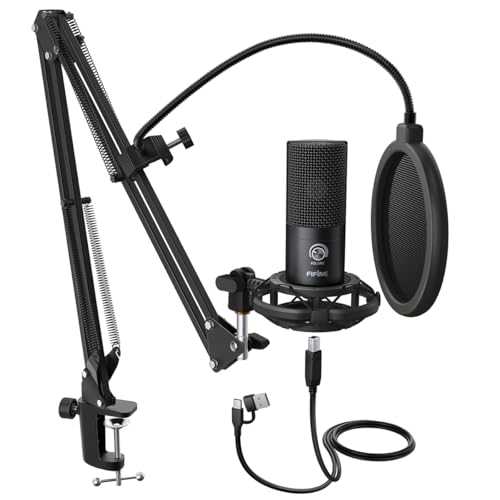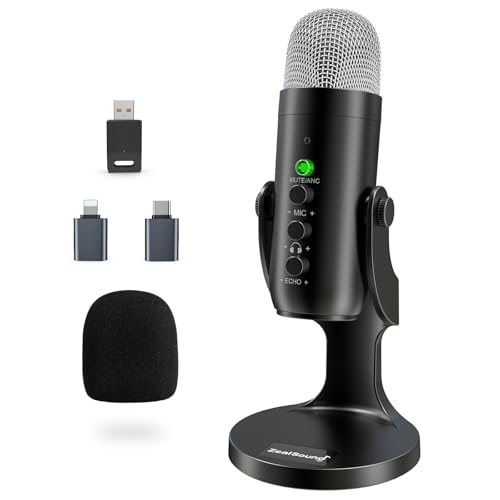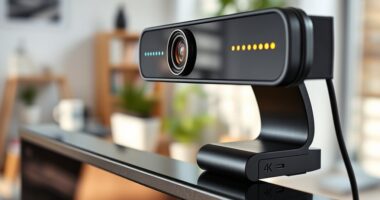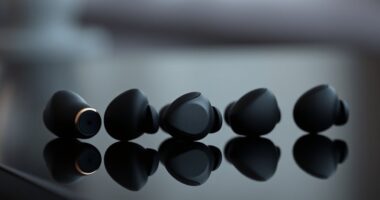If you’re looking for the best microphones for podcasters in 2025, I recommend options that blend studio-quality sound with ease of use. From dynamic microphones like the Pyle Vocal and Rode PodMic to wireless kits such as ZealSound and Sony ULT MIC, there’s a model for every setup. Many feature noise reduction, durable build quality, and versatile connectivity, making your recordings sound professional. Keep exploring to discover which mic suits your podcasting needs perfectly.
Key Takeaways
- Focus on microphones with professional-grade sound quality, wide frequency response, and high signal-to-noise ratio for studio-quality recordings.
- Prioritize models with noise reduction features like built-in pop filters, shock mounts, and cardioid or supercardioid pickup patterns.
- Consider versatile connectivity options such as USB, XLR, or hybrid systems compatible with multiple devices and platforms.
- Opt for durable, well-built microphones with rugged metal components suitable for long-term professional use.
- Select microphones offering user-friendly features like plug-and-play setup, onboard controls, and included accessories for streamlined operation.
MAONO Wireless Lavalier Microphone for iPhone/Android/Camera/PC
The MAONO Wireless Lavalier Microphone stands out as an excellent choice for content creators who need reliable, studio-quality audio on the go. Weighing just 9 grams, it’s compact and perfect for vloggers, filmmakers, and podcasters. It’s compatible with iPhone, Android, cameras, and PCs, thanks to included USB-C and Lightning plugs. The microphone features a durable ABS plastic build and offers professional sound with an 80dB signal-to-noise ratio and 120dB max sound pressure. With instant pairing, noise cancellation, and a range of up to 300 meters, it ensures clear, stable audio whether recording indoors or outdoors.
Best For: content creators such as vloggers, filmmakers, and podcasters seeking reliable, high-quality wireless audio on the go.
Pros:
- Lightweight and compact design (9g), ideal for portable use
- Studio-grade sound quality with 80dB signal-to-noise ratio and 120dB max sound pressure
- Long wireless range up to 300 meters with stable, interference-free transmission
Cons:
- Requires AAA battery (included), which may need periodic replacement
- Limited color options, primarily black
- May be less suitable for environments requiring ultra-high fidelity or professional-grade equipment
Studio Podcast Dynamic Microphone with Accessories
If you’re serious about capturing clear, studio-quality sound, the Studio Podcast Dynamic Microphone with Accessories is an excellent choice. It features a professional dynamic design with a unidirectional core, ensuring focused sound pickup and minimal background noise. The package includes a heavy-duty metal stand, dual-layer pop filter, and versatile cables for XLR and USB-C connections, making setup seamless. Its adjustable gain and real-time monitoring via the headphone jack give you full control over your recordings. With a solid build and high sensitivity, this mic suits vocals, voice-overs, and streaming, delivering professional sound quality at a competitive price.
Best For: content creators, podcasters, and streamers seeking professional-quality sound with versatile connectivity options and easy setup.
Pros:
- High sensitivity and wide frequency response for clear, studio-quality audio
- Includes comprehensive accessories like a heavy-duty stand, pop filter, and multiple cables for flexible setup
- Adjustable gain and real-time monitoring enhance control over recordings
Cons:
- Customer ratings are moderate at 3.8/5 stars, indicating some user concerns
- Heavy weight (3.44 pounds) may affect portability and ease of positioning
- Limited to a unidirectional pickup pattern, which might not suit multi-source recording environments
Wireless Lavalier Microphone for iPhone/Android Phone/Laptop/PC
A wireless Lavalier microphone stands out as an ideal choice for podcasters who need flexibility and high-quality audio without the hassle of cables. It’s compatible with iPhones, Android phones, tablets, laptops, MacBooks, and PCs, with plug-and-play connections via USB-C, Lightning, or USB-A ports—no apps or Bluetooth needed. Its 360° rotating clip allows precise mic positioning, while the omnidirectional design and intelligent noise reduction guarantee clear sound even in noisy environments. With up to 30 meters of wireless range, 8 hours of battery life, and real-time monitoring, it’s perfect for outdoor shoots, live streams, and interviews. Plus, it includes accessories and a 2-year warranty.
Best For: podcasters, content creators, and outdoor interviewers seeking high-quality, wireless audio with versatile device compatibility and easy plug-and-play setup.
Pros:
- Compatible with a wide range of devices including iPhone, Android, laptops, and PCs without the need for Bluetooth or apps
- Up to 30 meters of wireless range with minimal latency ensures freedom of movement during recording or live streaming
- Includes comprehensive accessories like earphones, adapters, and extra clips, plus a 2-year warranty for peace of mind
Cons:
- Some Android phones may require OTG activation for proper operation
- Limited to a maximum of 8 hours of battery life per charge, which may require planning for extended sessions
- The setup may be complex for users unfamiliar with device port configurations or without prior experience with wireless microphones
InnoGear Microphone Boom Arm with Cable Management
InnoGear’s Microphone Boom Arm with Cable Management stands out for its space-saving design and sleek aesthetics, making it perfect for podcasters with limited desk space or a minimalist setup. Its ultra-sleek, low-profile design keeps the lower arm just 3.35 inches above the desk, maximizing workspace. The integrated magnetic cable management keeps wires hidden and tangle-free, eliminating clutter and snagging. With full 360° rotation, 180° swivel, and 170° tilt, it offers precise positioning for ideal sound capture. Made from durable alloy steel, it supports mics up to 1.5 kg and attaches securely to desks up to 2.36 inches thick.
Best For: podcasters, streamers, and content creators seeking a space-efficient, adjustable microphone arm with cable management for clutter-free setups.
Pros:
- Space-saving, low-profile design maximizes desk space and maintains a sleek appearance
- Integrated magnetic cable management keeps wires organized, hidden, and tangle-free
- Full range of motion with 360° rotation, 180° swivel, and 170° tilt for precise positioning
Cons:
- Supports microphones up to 1.5 kg, which may be limiting for heavier mics
- Clamp suitable for desks up to 2.36 inches thick; may not fit thicker surfaces
- Assembly may require some initial adjustment for optimal stability and positioning
InnoGear Microphone Stand, 2 Pack Tripod Boom Arm with Carrying Bag and Mic Clips
For podcasters who need a versatile and portable microphone stand, the InnoGear 2 Pack Tripod Boom Arm offers an excellent solution. It features adjustable height from 28.1 to 89.8 inches, making it suitable for all users. The solid steel construction guarantees stability and durability, supporting various microphone weights. The flexible boom arm, adjustable from 16 to 30 inches, rotates 360° horizontally and 180° vertically, allowing customized positioning. It can be detached to serve as a straight stand. Plus, the package includes mic clips, a carrying bag, and an adapter, making it perfect for both indoor and outdoor use on the go.
Best For: podcasters, singers, and performers seeking a versatile, portable, and durable microphone stand for indoor and outdoor use.
Pros:
- Adjustable height from 28.1 to 89.8 inches for versatile positioning
- Flexible boom arm with 360° horizontal and 180° vertical rotation for customized setup
- Includes mic clips, adapter, and carrying bag for complete portability and compatibility
Cons:
- Slightly heavier at approximately 4.0 lbs, which may impact ease of transport for some users
- Assembly required when disassembling and packing the stand
- Compatibility depends on mic clip fit; some specific microphones may need additional adapters
HOTEC Dynamic Handheld Microphone with XLR Cable and ON/Off Switch
The HOTEC Dynamic Handheld Microphone with XLR Cable and ON/Off Switch stands out as an excellent choice for podcasters who need reliable, studio-quality sound on the go. Its cardioid pattern captures clear vocals while minimizing background noise, feedback, and distortion. Made of durable zinc alloy, it’s built to last, with a metal mesh that effectively reduces pop noise. The included 19ft detachable XLR cable and windscreen cover make setup easy, and the standard size fits most microphone stands. Whether for live performances or remote recordings, this microphone offers professional-grade sound, durability, and convenience at an affordable price.
Best For: podcasters, singers, and performers seeking reliable, studio-quality sound in both live and remote settings.
Pros:
- Cardioid pickup pattern effectively reduces background noise and feedback for clear vocals.
- Durable construction with zinc alloy body and metal mesh ensures longevity and pop noise reduction.
- Includes a long 19ft detachable XLR cable and windscreen for convenient setup and professional sound quality.
Cons:
- Being corded, it may limit mobility compared to wireless microphones.
- Slightly heavier weight (1 pound) may be less comfortable for extended handheld use.
- Compatibility requires devices with 1/4” input, which may need adapters for some modern equipment.
ZealSound XLR/USB Microphone for Gaming and Streaming
If you’re looking for a versatile microphone that seamlessly adapts to your gaming, streaming, or podcasting setup, the ZealSound XLR/USB Microphone is an excellent choice. It offers both USB and XLR connectivity, making it compatible with PCs, Macs, iPhones, and Android devices. The dynamic mic delivers clear, natural audio with noise rejection and a cardioid pattern, ideal for voice-focused content. Its customizable RGB lighting adds a visual flair, while features like tap-to-mute, real-time monitoring, and a detailed bundle make it user-friendly. Whether you’re streaming on Twitch or recording podcasts, this microphone combines flexibility, quality, and style in one package.
Best For: content creators, streamers, and podcasters seeking a versatile, high-quality microphone compatible with multiple devices and platforms.
Pros:
- Supports both USB and XLR connectivity for maximum flexibility and professional use.
- Customizable RGB lighting with multiple modes adds visual appeal during streams or recordings.
- Includes a complete bundle with accessories like boom arm, windscreen, adapters, and cables for all-in-one setup.
Cons:
- The microphone’s size and features may be more than necessary for casual users or basic streaming needs.
- RGB lighting, while customizable, may consume additional power and can be distracting for some users.
- Requires additional desk space for the boom arm and setup compared to smaller microphone options.
FIFINE K688 Podcast Microphone Kit with Boom Arm
The FIFINE K688 Podcast Microphone Kit with Boom Arm stands out as an excellent choice for podcasters seeking professional sound quality and convenience. Its XLR dynamic microphone provides natural, distortion-free sound with 130dB SPL, perfect for clear vocals. The cardioid pattern reduces background noise, while the included windscreen and shock mount suppress harsh noises and vibrations. With both USB and XLR connections, it offers versatile use—plug-and-play for quick setups or studio-grade XLR for professional recording. The sturdy metal boom arm minimizes vibrations, and intuitive controls like mute and gain knobs make operation easy. Overall, it’s a reliable, all-in-one solution for high-quality podcasting.
Best For: podcasters and content creators seeking professional-quality sound with versatile connectivity options and easy operation.
Pros:
- Delivers natural, distortion-free sound with 130dB SPL and cardioid pattern for focused vocals and reduced background noise.
- Offers both USB and XLR connections for flexible, quick setup or professional studio-grade recording.
- Includes durable metal boom arm and accessories like windscreen and shock mount for enhanced noise suppression and stability.
Cons:
- All user controls are inactive in XLR mode, requiring a mixer or audio interface for adjustments.
- The microphone requires recording within 2-6 inches for optimal input volume, which may be restrictive for some users.
- The kit might be bulkier or heavier compared to compact USB-only microphones, affecting portability.
FIFINE Studio Condenser USB Microphone Kit with Boom Arm and Shock Mount
For podcasters seeking a hassle-free setup that delivers professional sound quality, the FIFINE Studio Condenser USB Microphone Kit with Boom Arm and Shock Mount stands out. It offers a simple plug-and-play design compatible with Windows and Mac, making setup quick and straightforward without extra hardware. The cardioid condenser capsule captures clear vocals while minimizing background noise. Included accessories—boom arm, shock mount, pop filter, and USB cable—ensure versatile and professional recordings. Its rugged construction and adjustable arm provide durable, flexible positioning, perfect for vocals, streaming, or voiceovers. This kit combines convenience with high-quality audio, making it an excellent choice for home studios and content creators.
Best For: content creators, podcasters, and streamers seeking a professional-quality microphone with easy setup and versatile positioning for home or studio use.
Pros:
- Plug-and-play USB connectivity offers quick and hassle-free setup without additional hardware or drivers.
- Includes all essential accessories such as boom arm, shock mount, and pop filter for versatile recording options.
- Rugged construction with adjustable arm and mounting options ensures durability and flexible positioning.
Cons:
- Not compatible with Xbox consoles, limiting use with certain gaming setups.
- Fixed horizontal arm positions may limit extreme adjustments for some users.
- Designed primarily for voice and vocal recordings; may not be ideal for complex multi-instrument recording setups.
Sony Wireless Microphone for Karaoke (UOULTMIC1)
Looking for a wireless microphone that delivers bright, natural vocals perfect for karaoke nights? The Sony ULT MIC Wireless Microphone (UOULTMIC1) is an excellent choice. It includes two mics and a receiver, compatible with all ULT POWER SOUND Series speakers with a microphone jack. Designed for clear, vibrant sound, it features noise reduction technology that minimizes wind, breath, and interference. With up to 20 hours of battery life and quick charging, it’s perfect for extended performances. Its durable silicone damper adds resilience, making it ideal for lively karaoke sessions. This lightweight, easy-to-use system ranks well among wireless mics, enhancing your singing experience.
Best For: karaoke enthusiasts and performers seeking bright, clear vocal sound with long-lasting battery life and durability in a wireless microphone system.
Pros:
- Offers up to 20 hours of continuous use on a single charge, ideal for extended performances.
- Equipped with noise reduction technology to ensure natural and vibrant vocal quality.
- Includes durable silicone dampers that enhance resilience during lively singing sessions.
Cons:
- Weighs 9.9 ounces, which may be slightly heavy for prolonged handheld use.
- Operates on a single channel at 2.4 GHz, potentially limiting interference management in crowded environments.
- First available in April 2025, so limited user reviews and long-term reliability data are currently available.
Rode PodMic Cardioid Dynamic Broadcast Microphone, Black
If you want professional-quality sound without complicated setup, the Rode PodMic Cardioid Dynamic Broadcast Microphone in black is an excellent choice. It’s a broadcast-quality mic designed specifically for podcasting, with a cardioid pattern that focuses on your voice and cuts down background noise. The internal pop filter helps minimize plosives, making your recordings clearer, while the shock mounting reduces vibrations and handling noise. It’s compatible with RODECaster Pro and other high-quality interfaces, and its durable build ensures longevity. Overall, the PodMic delivers rich, balanced sound, making it perfect for those seeking studio-quality audio in a straightforward, reliable package.
Best For: Podcasters and broadcast professionals seeking high-quality, easy-to-use microphones for clear, natural voice recordings.
Pros:
- Focuses on voice with a cardioid polar pattern to reduce background noise
- Built-in pop filter and shock mounting for cleaner audio and reduced handling noise
- Compatible with RODECaster Pro and other high-quality interfaces for versatile use
Cons:
- May require an additional microphone stand or boom arm for optimal placement
- Limited to broadcast and studio environments; not ideal for live performances or field recording
- Slightly more expensive than entry-level dynamic microphones
Rockville GN20 20-Inch Gooseneck Microphone Stand
The Rockville GN20 20-Inch Gooseneck Microphone Stand stands out for its adjustable and versatile design, making it ideal for podcasters who need precise microphone positioning. Its rubberized clamp securely attaches to desks or tables up to 1.5 inches thick, preventing scratches while providing stability. The 20-inch gooseneck offers flexible bending and holds its shape firmly, ensuring reliable positioning during recordings or live sessions. Made from sturdy steel, it’s built for durability and stability. Plus, it’s compatible with a wide range of microphones thanks to universal threading options, and can work with accessories like smartphone holders and shock mounts for expanded use.
Best For: podcasters, DJs, and recording professionals seeking a durable, adjustable microphone stand for precise positioning during recordings or live performances.
Pros:
- Sturdy steel construction ensures durability and stability during use.
- Adjustable 20-inch gooseneck provides flexible positioning at any angle.
- Compatibility with various microphones and accessories enhances versatility.
Cons:
- Clamp may not fit surfaces thicker than 1.5 inches.
- May require additional accessories (like shock mounts) for expanded functionality.
- Steel material, while durable, may be heavier than lightweight alternatives.
ZealSound Gaming Microphone Kit with Boom Arm
The ZealSound Gaming Microphone Kit with Boom Arm stands out for its universal compatibility and plug-and-play design, making it ideal for streamers, gamers, and content creators who need quick setup with high-quality audio. It easily connects to PS4/5, Windows, Mac, iPhone, iPad, Android, and more without drivers. The microphone features an intelligent noise reduction chipset and a supercardioid pattern, ensuring clear vocals and noise rejection. The adjustable K66 arm provides stable positioning with 30.8 inches of movement, and onboard controls let me fine-tune gain, volume, and mute. Plus, the kit includes all accessories for professional recording and streaming.
Best For: streamers, gamers, and content creators seeking a high-quality, easy-to-use microphone kit with versatile compatibility and professional features.
Pros:
- Universal compatibility with multiple devices including PS4/5, Windows, Mac, iPhone, iPad, and Android, with no driver installation needed.
- Equipped with intelligent noise reduction and a supercardioid pattern for clear vocals and effective noise rejection.
- Adjustable, stable K66 arm with 30.8 inches of movement and onboard controls for gain, volume, and mute, plus direct monitoring.
Cons:
- The setup may be overkill for casual users who only need basic microphone functionality.
- The size and weight of the boom arm might require a sturdy, spacious desk for optimal placement.
- As a comprehensive kit, it may be more expensive compared to basic standalone microphones.
Pyle Dynamic Vocal Microphone with XLR Cable
For podcasters seeking durability and reliable sound reproduction, the Pyle Dynamic Vocal Microphone with XLR Cable stands out as a top choice. Its rugged all-metal build, zinc die-cast case, and steel mesh windscreen guarantee long-lasting performance. The cardioid pickup pattern minimizes background noise, capturing vocals or instruments with clarity and punch. It includes an integrated pop filter and a 15 ft professional-grade XLR-to-1/4″ cable for versatile connectivity. Designed for high gain before feedback and moisture resistance, this microphone is perfect for studio recordings, live performances, and everyday podcasting, delivering professional sound quality in any environment.
Best For: podcasters, live performers, and studio musicians seeking durable, clear-sounding microphones with reliable feedback control.
Pros:
- Rugged all-metal construction ensures long-lasting durability for frequent use
- Cardioid pickup pattern effectively minimizes background noise and feedback
- Comes with a professional-grade XLR-to-1/4″ cable for versatile connectivity
Cons:
- May require additional accessories for optimal mounting or stand use
- Slightly heavier than some plastic-bodied microphones, which could affect handling during extended use
- Limited to wired setup; lacks wireless options for greater mobility
ZealSound Wireless Microphone with Bluetooth for Podcast and Gaming
If you’re looking for a versatile microphone that combines wireless convenience with professional sound quality, the ZealSound Wireless Microphone with Bluetooth is an excellent choice for podcasters and gamers alike. Its next-gen 2.4GHz wireless tech guarantees lag-free, studio-grade audio for streaming, recording, or gaming. You can connect it easily to PCs, Macs, PS4/PS5, iPhones, or Android devices with included adapters—no drivers needed. The mic features onboard gain and echo controls, DSP noise-canceling, and a built-in mute indicator for real-time adjustments. With up to 16 hours of rechargeable power, a durable design, and a complete creator kit, it’s a flexible, high-quality solution for any content creator.
Best For: content creators, streamers, and remote professionals seeking high-quality, wireless microphone solutions compatible with multiple devices and platforms.
Pros:
- Seamless 2.4GHz wireless technology ensures lag-free, studio-grade audio without drivers.
- Adjustable gain and echo controls allow for customized professional sound quality.
- Long-lasting rechargeable battery provides up to 16 hours of use, ideal for extended sessions.
Cons:
- Bluetooth input only supports background music, not recording audio directly.
- Slightly bulkier design may be less portable compared to smaller microphones.
- Requires initial full charge before first use for optimal performance.
Factors to Consider When Choosing Microphones for Podcasters 2025

When selecting a microphone for podcasting in 2025, I focus on sound quality and clarity to guarantee professional results. I also consider the type of microphone and connectivity options that best fit my setup, along with noise cancellation features to minimize background sounds. Finally, portability and size matter if I record on the go or in different locations.
Sound Quality Clarity
Achieving superior sound quality in podcasting hinges on selecting microphones that deliver exceptional clarity. A wide frequency response, typically between 20Hz and 20kHz, ensures I capture the full audio spectrum, preserving all the nuances of my voice. Microphones with a high signal-to-noise ratio, 92dB or higher, help minimize background noise and electrical interference, making my recordings clearer. Choosing a cardioid or unidirectional polar pattern helps focus on my voice, reducing ambient sounds that could distract listeners. Low total harmonic distortion (THD) ensures my voice is reproduced accurately without unwanted artifacts. Additionally, recording at 48kHz/24-bit format captures detailed sound, preserving subtle nuances that elevate my podcast’s professional quality. These factors are essential for crystal-clear, engaging audio.
Microphone Type Choice
Choosing the right microphone type is essential for producing high-quality podcast audio in 2025. If you’re recording in a noisy environment, a dynamic microphone with a cardioid pattern is ideal because it isolates your voice and reduces background noise. For studio-quality sound, condenser microphones are excellent due to their higher sensitivity and wider frequency response, capturing more detail. USB microphones are perfect for beginners or home studios because they’re plug-and-play, requiring no extra equipment. XLR microphones are preferred by professionals, offering higher fidelity and durability for serious studio setups. Omnidirectional microphones capture sound from all directions, which works well for group recordings but can also pick up unwanted ambient noise. Consider your recording environment and needs when choosing your microphone type.
Connectivity Options Flexibility
Selecting a microphone with versatile connectivity options is crucial for podcasters in 2025, as it guarantees compatibility across various devices and recording setups. Microphones offering multiple connection types like USB, XLR, and wireless provide greater flexibility for different environments, from home studios to live events. Supporting both wired and wireless connections allows me to adapt seamlessly to any situation without sacrificing sound quality. Compatibility with a broad range of devices—such as PCs, Macs, smartphones, and audio interfaces—ensures smooth integration and future-proofing. Additionally, having adapters or dual-interface support (USB and XLR) adds even more flexibility for upgrades or changing needs. Wireless models with stable transmission and multiple modes give me the convenience of mobility, making them ideal for dynamic recording scenarios.
Noise Cancellation Features
Have you ever recorded in a noisy environment and struggled to hear your own voice clearly? That’s where noise cancellation features come in. Modern microphones often include built-in ENC chips and advanced algorithms that filter out ambient sounds and background noise during recording. Many models offer multiple noise cancellation modes with adjustable levels, allowing you to customize your sound environment based on your setting. Omnidirectional microphones with intelligent noise reduction can capture clear voice audio even amid chaos, reducing the need for post-production edits. Additionally, real-time monitoring and adjustable noise cancellation settings help maintain consistent audio quality during live sessions. Advanced tech like frequency-hopping and multiple noise reduction modes ensure your sound stays stable and clear over long distances.
Portability and Size
Portability and size are crucial factors when picking a microphone for podcasting in 2025, especially if you record on the go. Smaller, lightweight microphones are much easier to carry and set up, making them perfect for on-the-fly sessions. Their compact design allows them to fit into bags or cases effortlessly, ideal for frequent travelers. Many portable microphones also feature built-in batteries, so you don’t need external power sources, giving you more flexibility. Size and portability can greatly influence where and how you place your mic, especially in tight or unconventional environments. Choosing a microphone with minimal size means you gain convenience without sacrificing sound quality or durability. Overall, a portable mic ensures you’re always ready to record, wherever your podcast takes you.
Compatibility With Devices
When choosing a microphone for your podcast in 2025, ensuring compatibility with your devices is essential for a smooth recording process. First, check that the microphone supports your device’s connection type, such as USB-C, Lightning, or XLR, to avoid any compatibility issues. It’s also important to verify whether it works with your operating system—whether Windows, macOS, iOS, or Android—so you don’t run into setup problems. Some microphones are plug-and-play, while others need drivers or software, so understand what’s required before purchasing. Wireless options like Bluetooth or proprietary tech can add mobility but ensure your device supports these features. Lastly, confirm that the input type matches your existing audio interface or mixer for seamless integration.
Budget and Cost
Choosing the right microphone for your podcast often depends on your budget, as prices can vary widely—from budget-friendly options under $50 to professional-grade models costing several hundred dollars. Cheaper microphones usually lack advanced features like noise cancellation or multiple connectivity options, which can impact recording clarity. Spending a bit more can lead to better durability, higher sound quality, and longer-lasting components, offering better value over time. Keep in mind, budget microphones might require extra accessories like pop filters or stands, adding to the overall cost. Understanding your budget helps you prioritize essential features such as connectivity, sound fidelity, and durability, ensuring you select a microphone that meets both your financial constraints and technical needs without compromising quality.
Frequently Asked Questions
How Do Microphone Polar Patterns Affect Podcast Sound Quality?
Microphone polar patterns substantially impact podcast sound quality by shaping how they pick up sound. I choose cardioid patterns because they focus on my voice and reduce background noise, resulting in clearer recordings. Omnidirectional mics capture sound from all directions, which can introduce unwanted noise. Understanding these patterns helps me select the right mic for my environment, ensuring my podcast sounds professional and distraction-free.
What Are the Benefits of Using a Digital Versus Analog Microphone?
Digital microphones offer clearer sound quality, easier connectivity, and built-in features like noise reduction, making them ideal for podcasters who want convenience and professional results. Analog microphones, on the other hand, tend to be more affordable and provide warmer tones, but may require extra equipment and setup. I prefer digital mics for their simplicity and consistency, especially when I need reliable, studio-quality sound without hassle.
How Important Is Microphone Impedance for Podcast Clarity?
Microphone impedance is vital for podcast clarity because it directly affects how well your mic pairs with your audio interface. Too high or too low impedance can cause signal loss, noise, or distortion. I always check impedance ratings to guarantee compatibility, because clear sound isn’t just about the mic itself but about how it interfaces with your setup. Good impedance matching makes your voice crisp, clean, and professional.
Can Wireless Microphones Interfere With Other Devices During Recording?
Wireless microphones can sometimes interfere with other devices during recording, especially if they share the same frequency bands. I’ve noticed that background static or dropouts can happen when there’s lots of Wi-Fi, Bluetooth, or other wireless signals nearby. To minimize this, I always choose microphones with clear frequency options, use interference-resistant models, and keep other wireless devices away during recording. This helps guarantee a clean, professional sound.
What Are the Best Practices for Microphone Placement for Optimal Sound?
Think of microphone placement like planting a tree—you want it in the right spot for the best growth. I keep my mic about 6-12 inches from my mouth, slightly off to the side to avoid plosive sounds. I also use a pop filter and position the mic at a 45-degree angle, pointing toward my mouth. This setup captures clear, natural sound and minimizes background noise for professional-quality recordings.
Conclusion
Choosing the right microphone is about clarity, convenience, and connection. Whether you prefer wireless freedom, studio quality, or versatile stands, the options I’ve shared cover all your needs. Prioritize sound, portability, and ease of use to elevate your podcast. With the right mic, you’ll capture your voice perfectly, connect effortlessly, and create content that resonates. So, pick what suits your style—because your voice deserves to be heard clearly, confidently, and compellingly.

